NCERT Solutions Class 10 Maths
Chapter – 13 (Surface Areas and Volumes)
The NCERT Solutions in English Language for Class 10 Mathematics Chapter – 13 Surface Areas and Volumes Exercise 13.3 has been provided here to help the students in solving the questions from this exercise.
Chapter : 13 Surface Areas and Volumes
- NCERT Class 10 Maths Solution Ex – 13.1
- NCERT Class 10 Maths Solution Ex – 13.2
- NCERT Class 10 Maths Solution Ex – 13.4
- NCERT Class 10 Maths Solution Ex – 13.5
Exercise – 13.3
1. A metallic sphere of radius 4.2 cm is melted and recast into the shape of a cylinder of radius 6 cm. Find the height of the cylinder.
Solution – Given, the radius of the sphere (R) = 4.2 cm
Radius of the cylinder (r) = 6 cm
let the height of the cylinder = h
the volume of the sphere = Volume of the cylinder
⇒ (4/3)×π×R3 = π×r2×h
⇒ (4/3) × 4.2 × 4.2 × 4.2 = 6 × 6 × h
⇒ 4 × 1.4 × 4.2 × 4.2 = 6 × 6 × h
⇒ h = (4 × 1.4 × 4.2 × 4.2) / (6 × 6)
⇒ h = 2.74 cm
2. Metallic spheres of radii 6 cm, 8 cm and 10 cm, respectively, are melted to form a single solid sphere. Find the radius of the resulting sphere.
Solution –
For Sphere 1:
Radius (r1) = 6 cm
∴ Volume (V1) = (4/3) × π × r13
For Sphere 2:
Radius (r2) = 8 cm
∴ Volume (V2) = (4/3) × π × r23
For Sphere 3:
Radius (r3) = 10 cm
∴ Volume (V3) = (4/3) × π × r33
Also, let the radius of the resulting sphere be “r”
Now,
The volume of the resulting sphere = V1 + V2 + V3
⇒ (4/3) × π × r3 = (4/3)×π×r13 + (4/3)×π×r23 + (4/3)×π×r33
⇒ (4/3) × π × r3 = (4/3)×π [r13 + r23 + r33 ]
⇒ r3 = 63 + 83 + 103
⇒ r3 = 1728
⇒ r = 12 cm
3. A 20 m deep well with a diameter of 7 m is dug, and the earth from digging is evenly spread out to form a platform 22 m by 14 m. Find the height of the platform.
Solution – Given, the height of deep well which form a cylinder (h) = 20 m
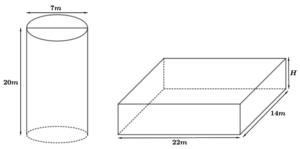
Depth of the cylindrical well, h = 20 m
Radius of the cylindrical well, r = 7/2 m
Length of the cuboidal platform, l = 22 m
Breadth of the cuboidal platform, b = 14 m
Let the height of the cuboidal platform = H
Volume of the cylindrical well = Volume of the cuboidal platform
⇒ πr2h = lbH
⇒ H = πr2h / lb
⇒ H = (22/7 × 7/2 × 7/2 × 20) / (22 × 14)
⇒ H = 5/2 m
⇒ H = 2.5 m
Therefore, the height of the platform will be 2.5 m.
4. A well of diameter 3 m is dug 14 m deep. The earth taken out of it has been spread evenly all around it in the shape of a circular ring of width 4 m to form an embankment. Find the height of the embankment.
Solution – The shape of the well will be cylindrical, as given below.
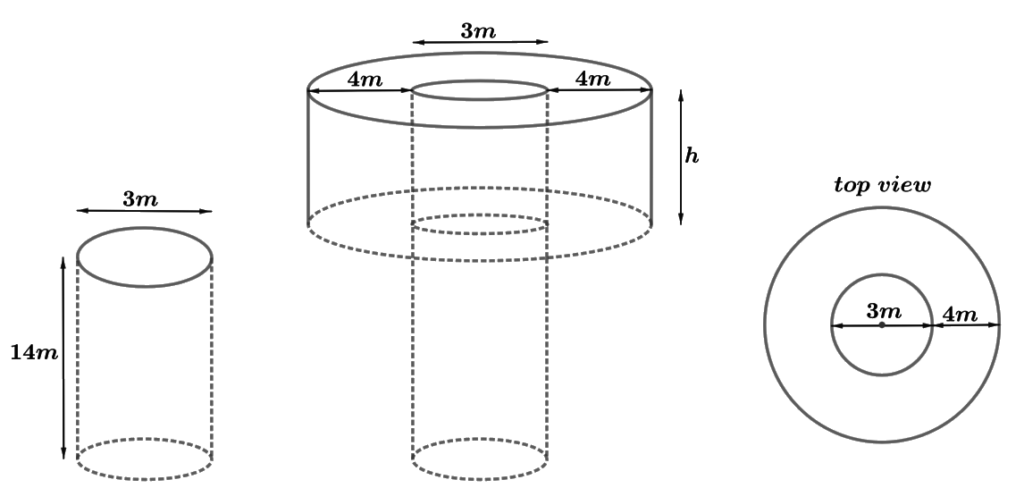
Given, depth (h1) of well = 14 m
Diameter of the circular end of the well = 3 m
So, Radius (r1) = 3/2 m
Width of the embankment = 4 m
Outer radius of the embankment, R = Inner radius + Width
R = 1.5 m + 4 m
= 5.5 m
Let the height of embankment be h
Volume of the cylindrical well = Volume of the hollow cylindrical embankment
⇒ πr²h₁ = πR²h – πr²h
⇒ πr²h₁ = πh (R² – r²)
⇒ r²h₁ = h (R – r )(R + r)
⇒ h = [(r²h₁)/(R – r)(R + r)]
⇒ h = [((1.5)² × 14)/(5.5 – 1.5)(5.5 + 1.5)]
⇒ h = (2.25 × 14)/(4 × 7)
⇒ h = 1.125 m
Therefore, the height of the embankment will be 1.125 m.
5. A container shaped like a right circular cylinder having a diameter of 12 cm and a height of 15 cm is full of ice cream. The ice cream is to be filled into cones of height 12 cm and diameter 6 cm, having a hemispherical shape on the top. Find the number of such cones which can be filled with ice cream.
Solution – Let the height and radius of ice cream container (cylinder) be h and r.
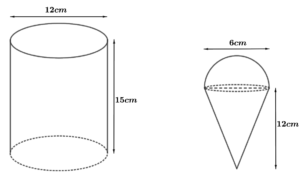
The number of cones will be = Volume of cylinder/Volume of ice cream cone
For the cylinder part,
Radius = 12/2 = 6 cm
Height = 15 cm
∴ Volume of cylinder = π×r2×h
= π×6×6×15
= 540π
For the ice cone part,
Radius of conical part = 6/2 = 3 cm
Height = 12 cm
Radius of hemispherical part = 6/2 = 3 cm
The volume of the ice cream cone = Volume of the conical part + Volume of the hemispherical part
= (⅓)×π×r2×h + (⅔)×π×r3
= (⅓)×π×3×3×12 + (⅔)×π×3×3×3
= 36π + 18π
= 54π
∴ Number of cones = (540π/54π)
= 10
Therefore, 10 ice cream cones can be filled with the ice cream in the container.
6. How many silver coins, 1.75 cm in diameter and of thickness 2 mm, must be melted to form a cuboid of dimensions 5.5 cm × 10 cm × 3.5 cm?
Solution – It is known that the coins are cylindrical in shape.

height (h1) of the cylinder = 2 mm = 0.2 cm
Radius (r) of circular end of coins = 1.75/2 = 0.875 cm
the number of coins to be melted to form the required cuboids be “n”
Volume of n coins = Volume of cuboids
n × π × r2 × h1 = l × b × h
n × π × (0.875)2 × 0.2 = 5.5 × 10 × 3.5
n × 22/7 × (0.875)2 × 0.2 = 5.5 × 10 × 3.5
n = (5.5 × 10 × 3.5)/(22/7 × (0.875)2 × 0.2)
n = (5.5 × 10 × 3.5 × 7)/(22 × 0.875 × 0.875 × 0.2)
n = 400
Therefore, the number of coins melted to form such a cuboid is 400.
7. A cylindrical bucket, 32 cm high and with a radius of a base of 18 cm, is filled with sand. This bucket is emptied on the ground, and a conical heap of sand is formed. If the height of the conical heap is 24 cm, find the radius and slant height of the heap.
Solution – The diagram will be as-

Given,
Height (h1) of cylindrical part of the bucket = 32 cm
Radius (r1) of circular end of the bucket = 18 cm
Height of the conical heap (h2) = 24 cm
Now, let r2 be the radius of the circular end of the conical heap.
We know that volume of the sand in the cylindrical bucket will be equal to the volume of sand in the conical heap.
∴ The volume of sand in the cylindrical bucket = Volume of sand in the conical heap
⇒ π×r12×h1 = (⅓)×π×r22×h2
⇒ π×182×32 = (⅓)×π ×r22×24
⇒ r22 = (18 × 18 × 32 × 3) / 24
⇒ r22 = 1296
⇒ r2= 36 cm
Slant height (l) = √(362 + 242)
= 12√13 cm.
Thus, the radius and slant height of the conical heap is 36 cm and 12√13 cm respectively.
8. Water in a canal, 6 m wide and 1.5 m deep, flows at a speed of 10 km/h. How much area will it irrigate in 30 minutes if 8 cm of standing water is needed?
Solution – It is given that the canal is the shape of a cuboid with dimensions as:
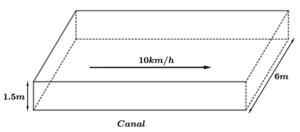
Breadth (b) = 6 m
Height (h) = 1.5 m
The speed of canal = 10 km/hr
Length of canal covered in 1 hour = 10 km
Length of canal covered in 60 minutes = 10 km
Length of canal covered in 1 min = (1/60) × 10 km
Length of canal covered in 30 min (l) = (30/60) × 10 = 5km = 5000 m
We know that the canal is cuboidal in shape.
The volume of the canal = l×b×h
= 5000 × 6 × 1.5 m3
= 45000 m3
Now, The volume of water in the canal = Volume of area irrigated
= Area irrigated × Height
Area irrigated = 56.25 hectares
∴ The volume of the canal = l×b×h
45000 = Area irrigated × 8 cm
45000 = Area irrigated × (8/100)m
Area irrigated = 562500 m2 = 56.25 hectares.
Therefore, 562500 m2 or 56.25 hectares area will be irrigated in 30 minutes.
9. A farmer connects a pipe of internal diameter 20 cm from a canal into a cylindrical tank in her field, which is 10 m in diameter and 2 m deep. If water flows through the pipe at the rate of 3 km/h, in how much time will the tank be filled?
Solution – Consider the following diagram
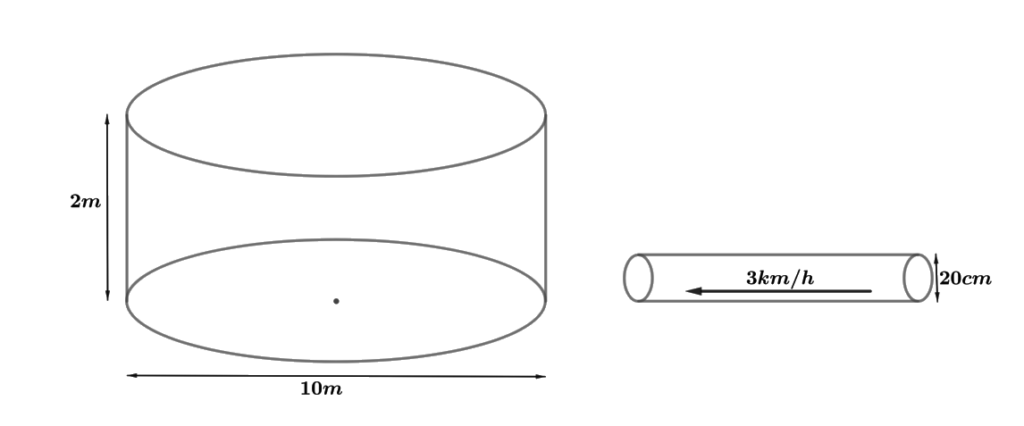
Radius of the cylindrical tank, R = 10 / 2 m = 5 m
Depth of the cylindrical tank, H = 2 m
Radius of the cylindrical pipe, r = 20/2 cm = 10/100 m = 0.1 m
Length of the water flowing through the pipe in 1 hour (60 minutes) = 3 km
Length of the water flowing through the pipe in 1 minute, h = 3 km/60 = (3 × 1000 m) /60 = 50 m
Volume of water flowing through pipe in ‘t’ minutes = volume of water in cylindrical tank
t × πr2h = πR2H
t = R2H / r2h
t = (5 × 5 × 2 ) / (0.1 × 0.1 × 50 )
t = 100
Therefore, the cylindrical tank will be filled in 100 minutes.

Leave a Reply